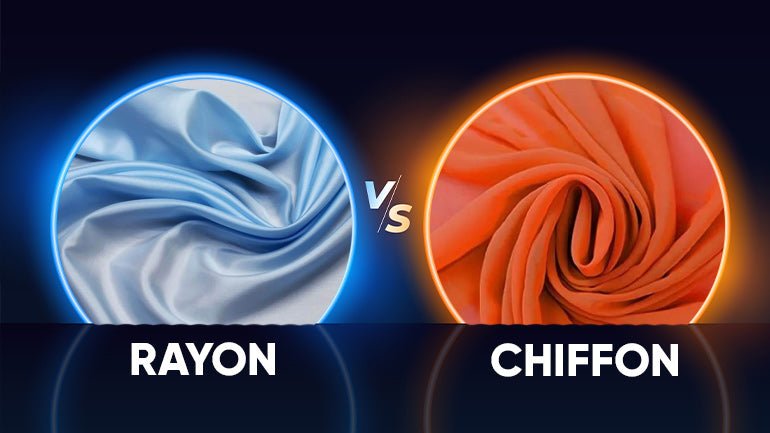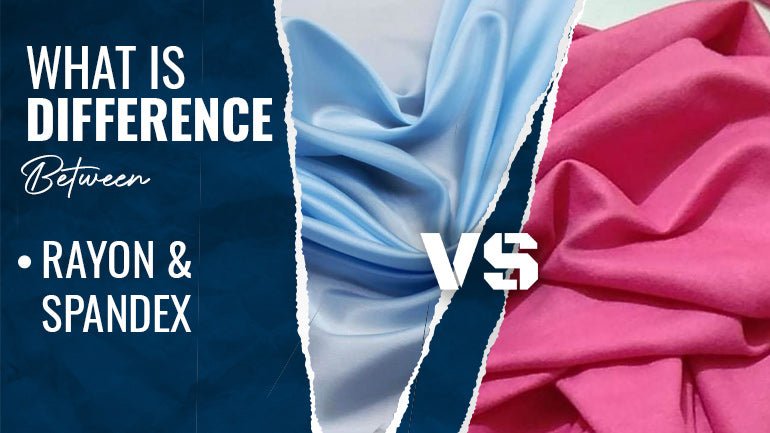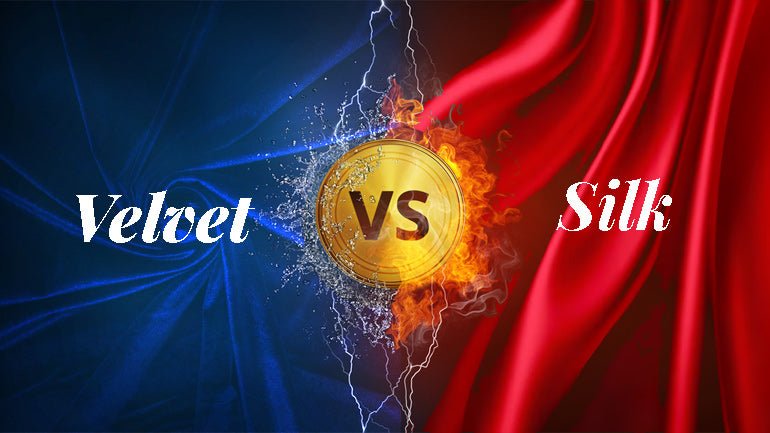In the textile industry chiffon and rayon are popular fabrics that can be used for multiple applications. While both have their unique attributes and applications, they cater to distinct tastes and requirements.
Chiffon is a fabric renowned for its ethereal quality and delicate drape. Its lightweight nature and sheer appearance make it a popular choice for elegant and formal attire, such as evening gowns and bridal wear. What sets chiffon apart is its ability to create an otherworldly aura, with its fabric gently swaying and floating with every movement.
Rayon, on the other hand, is a semi-synthetic fiber born from natural sources. It undergoes a complex chemical process that transforms natural cellulose, obtained from materials like wood pulp, bamboo, or cotton, into a versatile textile fiber. Rayon is celebrated for its adaptability and comfort, making it a favored choice across industries, from fashion to upholstery.
In this blog post, we will discuss chiffon vs. rayon, exploring their properties, environmental impact, manufacturing processes, common uses and many more.
How does Chiffon Fabric Differ from Rayon?
Fiber Sources
Chiffon: Chiffon can be fashioned from various fibers, including silk, polyester, and nylon. Each of these fibers contributes to the fabric's texture, sheerness, and overall appearance. Silk chiffon, for instance, boasts a luxurious feel and a natural luster that adds opulence to any garment.
Rayon: Rayon, while derived from natural sources such as wood pulp, bamboo, or cotton, presents a more intricate process of creation. The variations within rayon, such as lyocell and modal, arise from utilizing specific fiber sources. This results in tailored properties, catering to different needs and applications, be it clothing, upholstery, or home textiles.
Environmental Impact
Chiffon: Chiffon, though dependent on the chosen fiber, can be a mixed bag in terms of sustainability. Natural fibers like silk offer lower environmental footprints than synthetic counterparts like polyester or nylon. However, silk production involves energy-intensive processes and considerations about the well-being of silkworms, adding layers to the environmental debate.
Rayon: Rayon mirrors this complexity. Traditional rayon production methods employ chemicals and solvents that pose environmental hazards if not managed meticulously. Nevertheless, eco-friendly variations like lyocell and modal introduce closed-loop systems and sustainable practices, reducing the ecological consequences and fostering more responsible production methods.
Manufacturing Process
Chiffon: Chiffon undergoes a weaving or knitting process to bring different fibers together. The specifics of this process are tailored to the chosen fiber and the desired characteristics of the final chiffon fabric.
Rayon: Rayon encompasses a more intricate journey. The manufacturing process involves extracting cellulose from sources like wood pulp or bamboo. This cellulose is then dissolved and regenerated into fiber form through a series of chemical treatments. The method employed significantly impacts the fabric's environmental sustainability, underscoring the importance of responsible production practices.
Chemicals Used
Chiffon: Chiffon takes cues from the fibers it's made of. Natural dyes are often employed for silk-based chiffon, emphasizing the harmony between the fabric and nature. Conversely, synthetic fibers might entail the use of chemical dyes and finishing agents.
Rayon: Rayon production involves a more chemical-intensive process. Traditional methods might employ chemicals like carbon disulfide, which can have adverse effects on both human health and the environment. However, the advent of eco-friendly rayon variations prioritizes more sustainable chemical processes, enhancing the balance between innovation and responsibility.
Sheerness
Chiffon: Chiffon's elegance lies in its soft and sheerness. The lightweight nature of chiffon enhances this quality, contributing to the fabric's popularity in formal and flowy designs. Its sheer characteristic, allowing light to pass through, creates an airy and enchanting effect.
Rayon: Rayon holds its own in terms of drape. Its fluidity and softness enable graceful and flattering silhouettes, making it a preferred choice for various garments and textile applications. While some rayon fabrics may exhibit sheerness, others can present an opaque allure, with factors like weave, fiber blend, and fabric weight influencing this attribute.
Common Uses
Chiffon: Chiffon's lightweight and sheer attributes render it a prime contender for elegant and formal attire. It graces evening gowns, bridal wear, and flowy dresses with an air of romance and sophistication. Its ability to create dreamlike designs makes it indispensable in the world of couture.
Rayon: Rayon's versatility transcends boundaries. Found in industries ranging from apparel to upholstery and home textiles, it takes the shape of clothing, curtains, bedding, and more. Its adaptability strikes a chord with everyday wear and interior decor, showcasing the fabric's ability to metamorphose into a range of products.
The Blend of Possibilities
Chiffon: By blending chiffon with silk, a luxurious tactile experience is achieved. On the other hand, partnering with polyester or nylon infuses the fabric with enhanced durability and resistance against wrinkles.
Rayon: The versatility of rayon is further pronounced through blending. Whether it's a fusion with cotton for added strength and breathability, or a union with polyester for performance enhancements, rayon's adaptability continues to shine through.
Comfort
Chiffon: As the sun’s warmth envelops the world, chiffon comes forth as a beacon of comfort. Its lightweight and breathable composition make it a desirable choice in hot weather. The soft texture and delicate drape contribute to an experience that is as comfortable as it is stylish.
Rayon: Rayon shares a similar sentiment when it comes to comfort. The soft and smooth texture of rayon presents an inviting embrace against the skin, offering breathability that aligns well with various clothing applications.
Care
Chiffon: The delicate nature of chiffon calls for special care. Hand-washing or a gentle cycle with mild detergent is often recommended. While air drying or gentle ironing are preferred, the avoidance of machine drying is advisable to maintain the fabric's integrity.
Rayon: Rayon generally adheres to standard care instructions. Machine washing on a gentle cycle and low-heat tumble-drying are common practices. However, care routines may vary based on the type of rayon and garment construction.
Durability
Chiffon: The durability of chiffon varies according to the chosen fiber and fabric construction. Silk-based chiffon leans towards fragility, necessitating cautious handling. Conversely, chiffon woven from synthetic fibers like polyester or nylon exhibits a more robust resistance to tears.
Rayon: Rayon's durability is influenced by its type and weave. Some variations are more susceptible to wear and tear, while others exhibit commendable resilience, especially when blended with other fibers.
Moisture Absorption
Chiffon: Moisture absorption is not a forte of chiffon, particularly when silk or other natural fibers are involved. Instead of retaining moisture, chiffon tends to facilitate its passage through the fabric, thereby preserving its lightweight and breathable disposition.
Rayon: Rayon achieves a balanced middle ground in moisture management. While it can absorb some moisture, it also excels at wicking moisture away from the body, maintaining breathability and comfort.
Texture
Chiffon: The texture of chiffon is characterized by smoothness and delicacy. Its ethereal presence is upheld by its lightweight and airy feel, providing a soft touch that resonates with sophistication. The choice of fiber, whether silk, polyester, or nylon, results in subtle textural distinctions.
Rayon: Rayon's texture harmonizes with the natural fibers it often emulates. Its soft and smooth feel echoes the embrace of fabrics like cotton or silk, while variations in texture stem from the intricacies of fabric construction.
Price range
Chiffon: The price of chiffon hinges on factors like fiber type, fabric quality, and brand reputation. Silk chiffon reaches higher price brackets, whereas synthetically-derived versions can be budget-friendly.
Rayon: Rayon holds a favorable position in the affordability arena, particularly when compared to luxury fabrics such as natural silk. Factors like rayon type, fiber blend, and production processes contribute to its pricing diversity.
The Wrinkle Resistance
Chiffon: Wrinkles find an accommodating home in chiffon's lightweight folds. Creasing is an intrinsic trait of this fabric, necessitating gentle steaming or low-temperature ironing to restore its flawlessly smooth appearance.
Rayon: Wrinkle tendencies in rayon are influenced by the fabric's type and construction. While some rayon variants display resistance to wrinkles, others might benefit from ironing or steaming for a polished finish.
Breathability
Chiffon: A breath of fresh air awaits in chiffon's delicate layers. The fabric's sheer quality and lightweight nature invite air circulation, providing a cooling haven for the body, particularly in garments tailored for breathability.
Rayon: The breathable nature of rayon parallels that of chiffon. With air circulation at its core, rayon's ability to moderate body temperature grants comfort across varied climates.
Versatility
Chiffon: The allure of chiffon flourishes in the realm of elegance and formality. Eveningwear, bridal gowns, and dresses that yearn for movement find their perfect match in chiffons flowing. The fabric's versatility is mirrored in its diverse color palettes, prints, and textures, presenting a palette of creative possibilities.
Rayon: Rayon is a versatile option. From dresses and shirts to home textiles and upholstery, rayon can be used for all types of applications.
Availability
Chiffon: Chiffon is a fabric that can be crafted from a variety of fibers, including silk, polyester, and nylon.. chiffon made from different fibers is available at affordable prices at Ice Fabrics.
Rayon: Rayon, on the other hand, is easily obtainable in the textile industry. It's a semi-synthetic fiber derived from natural cellulose, commonly sourced from wood pulp or bamboo. This fiber is then chemically processed to create a textile material. Rayon fabrics in various blends, finishes, and textures are produced and available at our store. This adaptability ensures that rayon can cater to a wide range of project requirements and design choices.
Drapability
Chiffon: Chiffon is popular for its flowing and graceful drape. Its lightweight and sheer nature enables it to cascade elegantly on the body, resulting in a feminine and refined appearance. This quality adds movement and fluidity to garments, enhancing their visual appeal.
Rayon: Rayon has remarkable drapability. Its softness and fluidity allow it to drape smoothly and conform to the body's contours. This characteristic yields garments that not only flatter the wearer's silhouette but also lend a sense of comfort and ease of movement.
Aesthetic Appeal
Chiffon: Chiffon is famed for its ethereal and romantic appearance. Its lightweight and sheer attributes contribute to a delicate and airy look that has cemented its popularity in formal and elegant designs. Chiffon's usage often results in garments that exude sophistication and grace.
Rayon: Rayon, on the other hand, presents a versatile aesthetic range. Depending on the specific fabrication, rayon can exhibit various appearances, resembling natural fibers like cotton or silk. This adaptability allows designers to create a wide spectrum of styles and looks, from casual to formal, modern to classic.
Production Processes
The fabrication of chiffon and rayon hinges on vastly different production processes. Chiffon is created by weaving or knitting together various fibers. The particular techniques employed can vary based on the desired texture and characteristics of the final chiffon fabric. This process involves combining fibers to produce a lightweight and sheer fabric with a delicate appearance.
Rayon, however, undergoes a more intricate production journey. It starts with the extraction of natural cellulose from sources like wood pulp or bamboo. This cellulose is then dissolved and regenerated into a fiber through chemical treatments. The specific method employed in this conversion process can influence the resulting properties and environmental sustainability of the rayon fabric. The transformation of cellulose into rayon material leads to a semi-synthetic fiber that exhibits qualities akin to both natural and synthetic textiles.
Chiffon vs Rayon: Comparison Table
|
Features |
Chiffon |
Rayon |
|
Fiber Sources |
Silk, Polyester, Nylon |
Wood Pulp, Bamboo, Cotton |
|
Environmental Impact |
Mixed, dependent on fiber choice |
Varied, eco-friendly options available |
|
Manufacturing Process |
Weaving or Knitting |
Chemical conversion process |
|
Chemicals Used |
Natural and Synthetic Dyes |
Chemical-intensive, eco-friendly options |
|
Sheerness |
Lightweight and Sheer |
Drape varies, can be sheer or opaque |
|
Common Uses |
Elegant and Formal Attire |
Versatile across industries |
|
Comfort |
Lightweight and Breathable |
Soft and Smooth, comfortable |
|
Durability |
Varies with Fiber and Fabric Construction |
Depends on Rayon type and weave |
|
Moisture Absorption |
Passage of Moisture |
Moderate absorption, good wicking |
|
Texture |
Smooth and Delicate |
Soft and Smooth |
|
Wrinkle Resistance |
Prone to Wrinkles |
Varies, some variants resist wrinkles |
|
Breathability |
Lightweight and Airy |
Promotes air circulation |
|
Sustainability |
Organic silk option available |
Eco-friendly variations available |
|
Versatility |
Elegance and Formality |
Versatile for various applications |
|
Drapability |
Flowing and Graceful |
Soft and Conforming |
|
Aesthetic Appeal |
Romantic |
Versatile Aesthetics |
|
Production Processes |
Weaving/Knitting |
Chemical Conversion |
|
Availability |
Available from various fibers |
Widely available in textile industry |
Faqs
Is chiffon more expensive than rayon?
Chiffon's cost can be higher than rayon due to its delicate nature and intricate manufacturing process.
Which fabric, chiffon or rayon, is more wrinkle-resistant?
Rayon tends to be more wrinkle-resistant compared to chiffon, which is known for its lightweight and flowy texture.



